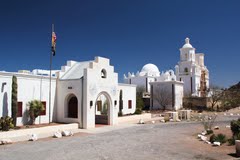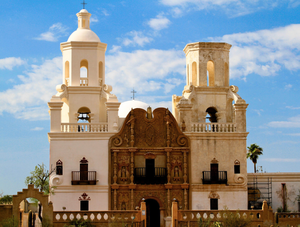 San Xavier Mission (photo from IridiumEX Deviant Art)
San Xavier Mission (photo from IridiumEX Deviant Art)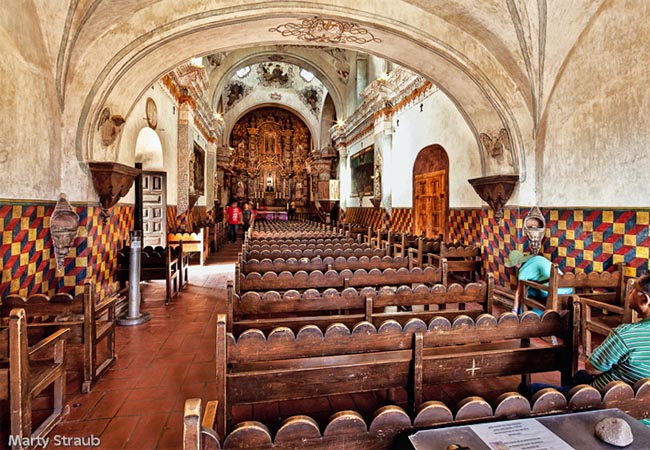
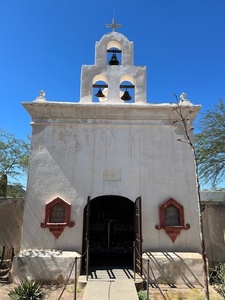 San Xavier Mission- Picture by Carlota Larson
San Xavier Mission- Picture by Carlota Larson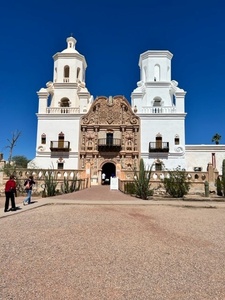 San Xavier Mission- Picture by Carlota Larson
San Xavier Mission- Picture by Carlota Larson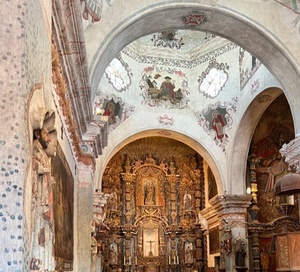 San Xavier Mission- Inside the Church- Picture by Carlota Larson
San Xavier Mission- Inside the Church- Picture by Carlota Larson
History
Known as "The White Dove of the Desert," the Catholic mission was established by Father Eusebio Kino in 1692. It was not until the 1700’s that Father Kino started to build foundations on what would be the Church. He was able to set his foundations before his demise in 1711. This subsequently inspired Father Espinosa to erect the first church in 1756. However, it was not until 1783 when the current edifice of the church was begun by Franciscan missionary FR. Juan Bautista Velderrain. It was brought to perfection after getting financing from an anonymous Sonoran Rancher. Father Juan engaged Ignacio Gaona and his staff to create the current church.
Following Mexican independence in 1821, San Xavier became part of Mexico. With the Gadsden Purchase of 1854, the Mission joined the United States. In 1859 San Xavier became part of the Diocese of Santa Fe. In 1866 Tucson became an incipient diocese and regular services were performed at the Mission once more.
In 1872 the Sisters of St. Joseph of Carondelet were able to establish a school attached to the Mission. After such incidents the Franciscans returned to the Mission in 1913. Ever since then the Mission has become an independent non-profit corporation as a tribute to the culture, reflecting the heritage.
The mission stands inside the limits of the San Xavier Indian Reservation, which is part of the Tohono O'odham Nation, situated Southwest of Tucson. The current white adobe building dates back to 1797 and is the oldest European structure still standing in Arizona. Unlike other Spanish missions in the region, which have Piman influence in the architecture, San Xavier is purely European in its design. It is largely regarded to be the outstanding example of Spanish Colonial architecture in the United States. One unique part of the building is the sculpture above the doors which represent a cat threatening a mouse. There is a tradition that states if the cat ever captures the mouse it will be the end of the world. Roughly 200,000 tourists travel each year to see this National Historic Monument from across the globe to witness what is regarded to be the best example of Spanish Colonial architecture in the United States.
An earthquake destroyed the church in 1887, but repairs did not commence until 1905 by Bishop Granjon. In 1939, lightning hit and shattered the 18th century lantern atop the west tower, and repairs were not complete until 1953. It was constructed out of ordinary home brick and mortar and renovated again in 2007 using threaded fiberglass. The fiberglass reinforced rodding in the minitower legs, preventing the metal rods from acting as a lightning rod. But the East Tower was never finished because the contractors ran out of money. To this day, the church's interior remains incomplete. There are several additional hypotheses that are stated as to why the East tower was never built, a few legends include:
- Someone fell off the tower, and work was halted.
- If a building was unfinished, its owners didn't have to pay tax on it.
- A cyclone blew the dome off the east tower, and it was never replaced.
School
The purpose of the school is to ensure that all students and faculty have access to the required safety measures so that learning may be maximized. It is the first Catholic school in Arizona since it began in November 1864. It was created and originally inaugurated by Vincent under the leadership of Bishop Salpointe. The Sisters worked at this school from 1873 until 1932 until the Immaculate Heart Sisters maintained duty. Starting in 1938 the Sisters of St. Joseph of Orange supervised the school until 1940. They school has accomplished in growing the school to eighth grade, and still continue to serve the school this current day. As of October 2022, the school has a re-entry and hybrid learning plan owing to COVID-19. Student get two days of in person learning and three days of online education. One perk to online students is there is free Wi-fi at the San Xavier Education Center from 8am-4pm.
Architecture
Spanish missions were erected often as European colonialism advanced north from Mexico into what is now Arizona. New Spain made an attempt like this to bring Christianity and Spanish culture to the local indigenous population. In the instance of San Xavier, the Pima-speaking people residing in this valley were, and are now, known as the Tohono O'odham (T.O.) people. During the mission's construction, T.O. males did the bulk of the manual work required to erect the adobe building. A private catholic school educating predominantly Native American pupils has been present on the property since The Sisters of Carondelet built one there in 1872.

Low-fire brick, stone, and lime mortar were used in Ignacio Gaona's construction of the Mission. The whole edifice is roofed with brick vaults, making it particularly distinctive among Spanish Colonial structures. It's safe to say that the church's distinctively Baroque style sets it apart. Theatrical curtain displays, false doors, marbling, and a sense of balance are just some of the fun, dramatic elements that characterize this design. The Franciscan cord is prominently featured on the outside and throughout the interior of the church. Window treatments, the sanctuary, the facade, and other interior decorations all have a shell motif in honor of Santiago, the patron saint of Spain (also known as "James the Greater").
Patronato San Xavier
Patronato San Xavier is an organization that is dedicated to the conservation of San Xavier Mission. To learn more about their work or to donate you can visit their website www.patronatosanxavier.org.
With the help of its patrons, Patronato San Xavier has collected over $11 million to fund the mission's upkeep and refurbishment throughout the years. For example, there will be a multi-year effort to repair the altar and the artwork within the building (which most was never originally finished). In order to repair the East-tower, the Patronato is presently accepting donations.
Location
The Mission is 9 miles south of downtown Tucson, Arizona just off of Interstate 19. Take exit 92 (San Xavier Road) and follow signs to the Mission.
Contact, Hours of Operation and Mass Days and Times
As of October 2022: MUSEUM IS CLOSED UNTIL FURTHER NOTICE (NO TOURS)- Facemasks and social distancing are required.
- Church and Mausoleum: Open Monday-Sunday 9am-4pm
- Gift Shop: Open Monday-Sunday 8am-5pm
- Mass Days and times:
Saturday @ 5pm
Sunday @ 10am & 12pm
- Confessions: Saturday @4pm or by appointment
If there is an emergency and someone needs to immediately speak with a priest- call 520-294-3015.
Emergency Services
If you have an emergency outside of normal business hours, San Xavier Mission is there to help. A priest may be reached via phone after hours through a dedicated answering service. The priest will call you and discuss your issue. There are two ways to get in touch with a priest in an emergency: you may chat to him, or he will go to wherever he has to go (depending on the distance) to bless a house, read last rites, or deal with whatever other urgent need has come to the attention of the church or the priest.
References:
https://www.newadvent.org/cathen/13464b.htm
https://patronatosanxavier.org/
https://scenicusa.net/011006.html
http://www.sanxaviermission.org
https://tucson.com/news/local/mission-san-xavier-del-bac-things-to-know/collection_7f960646-c479-11e5-9930-8784f4caa866.html#3



